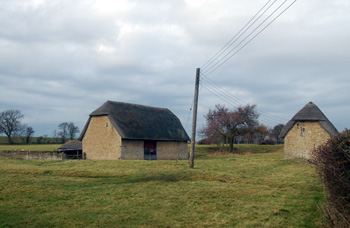![Hart Farm 1960 [Z53/112/19]](/CommunityHistories/Stevington/StevingtonImages/Hart Farm 1960 [Z53-112-19].jpg)
Hart Farm 1960 [Z53/112/19]
Hart Farmhouse was listed by the former Department of Environment in June 1974 as Grade II, of special interest. The Department dated the building to the 17th century and, like many of the older buildings in the area, it is constructed of coursed limestone rubble. It is in an H-plan and has two storeys under an old clay tile roof.
Bedfordshire and Luton Archives and Records Service has a small number of deeds probably taking the history of the farm back to the 18th and early 19th centuries. The farm is not named but Hart Farm seems the best candidate. The farmhouse was then copyhold of the Manor of Stevington and in 1775 Elizabeth Braine surrendered all her copyhold property in Stevington to her son, Samuel [Z793/78]. In 1784 he took out a £650 mortgage with George Rowles of Roxton which showed that part of the deal with his mother, who was still alive, had been that he paid her an annuity of £30. The farm comprised 72 acres and had been in the occupation of Thomas Bolton but was now occupied by Braine himself [Z793/80]. Six years later Rowles assigned the mortgage to John Grant of Great Barford [Z793/81]. In 1803 the mortgage was again assigned this time to William Leigh of Beeston, Sandy, corn factor, Braine taking a £50 further advance into the bargain [Z793/84]. Leigh died the following year and in 1808 the mortgage was transferred to Robert Lee of Newport Pagnell [Buckinghamshire], draper [Z793/84]. Lee died in 1810 and Braine then paid off the mortgage [Z793/84]. The Braines were clearly Baptists as in January 1808 Elizabeth, who had presumably received her £30 annuity for the past 33 years, was buried at the West End Meeting.
Directories tell us that in 1903 William Hensman Robinson was at Hart Farm, but the family may have been there earlier as he is listed as at West End Farm in directories of 1898 and 1894 and the two farms were later certainly farmed together. James Charles Robinson is listed as at West End Farm in directories of 1885 and 1890 (he had been at Manor Farm until the mid 1880s) and in a directory of 1877 John William Henry Robinson is listed at West End Farm. The current owner told the writer that when the Robinson family moved into Hart Farmhouse the ground floorhad been used as pigsties - this may have been between 1898 and 1903.
It is not generally realised but the U-Boat menace was as sever in the First World War as in the Second. By 1917 Britain was looking at a very serious situation given the large amounts of merchant shipping that were being sunk. In desperation War Agricultural Executive Committees of each County Council were asked to find land which could be ploughed up for food. Not surprisingly this ancient grassland was often not suitable for arable farming and the farmers involved usually objected. One such was Anne Robinson of Hart Farm [WW1/AC/OP1/1]. Fortunately the introduction of the convoy system brought the losses of merchant shipping back to acceptable levels.
The Rating and Valuation Act 1925 specified that every building and piece of land in the country was to be assessed to determine its rateable value. Stevington was assessed in 1926 and the valuer visiting Hart Farm [DV1/H8/14] noted that it was owned and occupied by "Mrs. Robinson & Son" and was farmed along with West End Farm, a combined total of about 254 acres. The farms had been bought in 1907 for £3,250. The sporting rights were let to a corn dealer named J. H. Smith for £15 per annum. The valuer commented: "Home Buildings Bad - but 3 lots all together. Mostly stone built. Lotof Thatch. Expensive. Onions on S. East".
Hart Farmhouse comprised two reception rooms, a kitchen, two pantries and a dairy with five bedrooms and a bathroom upstairs. Water came from a pump. The valuer's comment on the house was: "Old and roof in bad repair". The farm buildings near the house comprised two nag stables, a coach house, a cart house, a stable with a loft over, a three bay hovel, five calf pens and a barn.

Hart Farm Barns December 2008
The farm buildings included a four bay open hovel and a barn north of the farmhouse. These are the two barns, listed by the former Department of Environment in June 1974 as Grade II, of special interest. Both are 18th century buildings constructed of coursed limestone rubble and with thatched roofs. Presumably one was open to the sky in 1926. The farm buildings at West End Farm, opposite West End Baptist Meeting, comprised stabling for six horses, with a loft over, a loose box, a dovehouse, a seven bay open hovel and a barn for mixing and grinding.
The valuer commented on the farm buildings: "Stone construction with various roofings. Cost about £100 per annum to keep in repair". He also noted: "Bad bottom to Rickyard". It was: "7 miles to market".
Annie Robinson last appears in a directory of 1928. Kelly's Directory for 1931, 1936 and 1940 list George Robinson at Hart Farm.